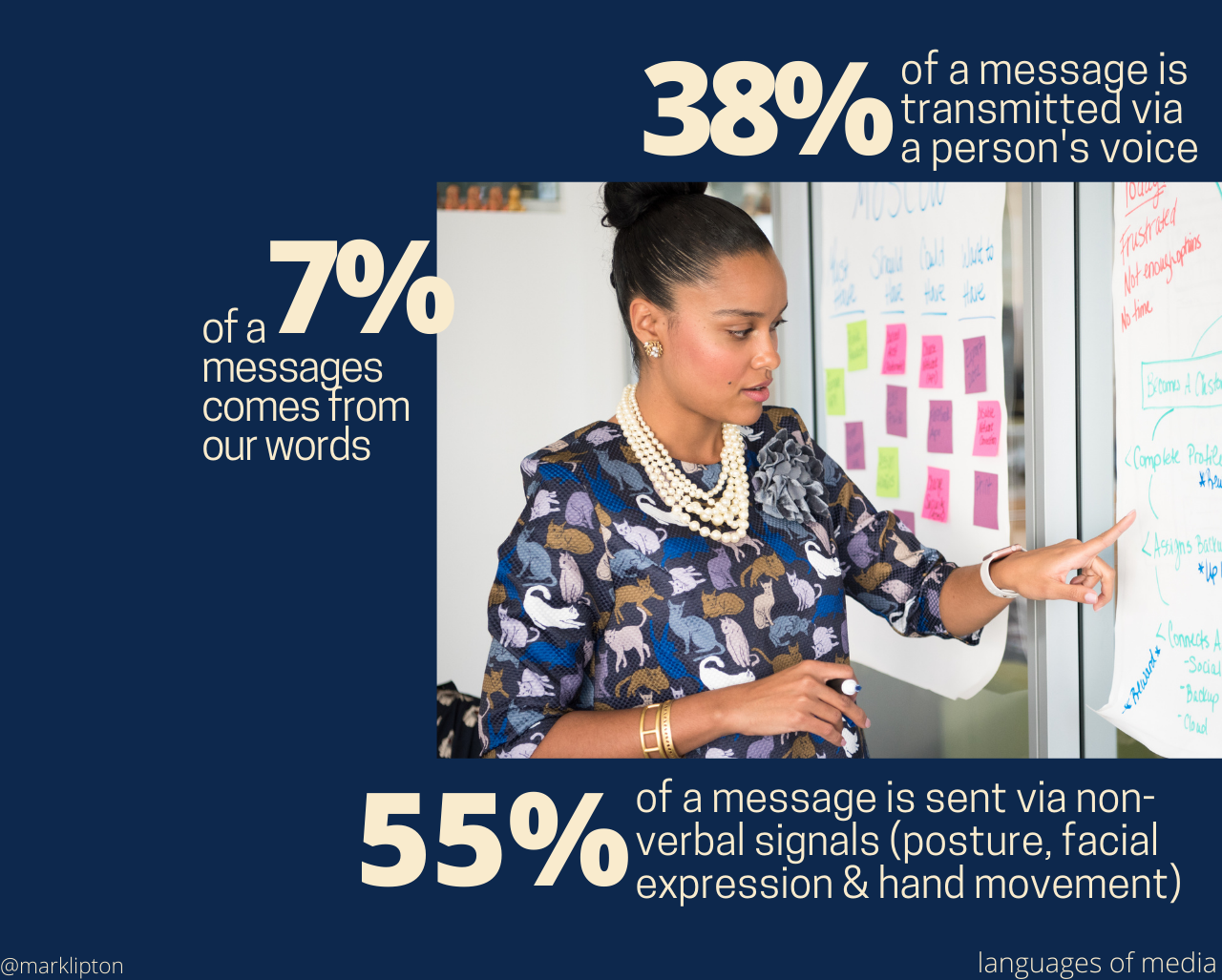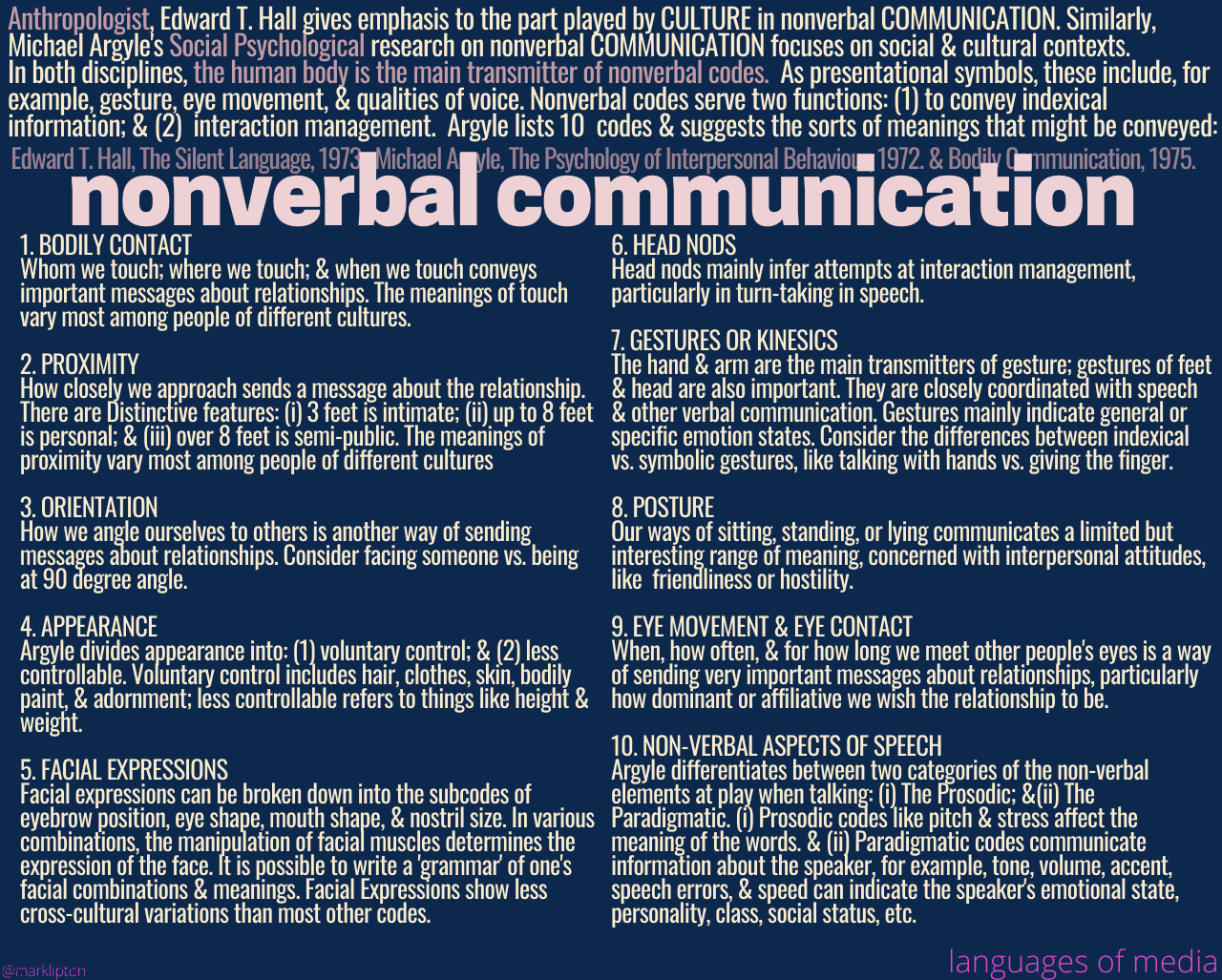Non-Verbal Communication
non-verbal communication

7% of a message comes from our words;
55% of a message is sent via non-verbal signals (posture, facial expression & hand movement.

Alt/Text: Nonverbal Communication
Anthropologist, Edward T. Hall gives greater emphasis to the part played by culture in nonverbal communication. Similarly, British authority on the social psychological approaches to the study of nonverbal communication, Michael Argyle’s account focuses on the social & cultural contexts.
The human body is the main transmitter of nonverbal codes. As presentational symbols, these may include, for example, gesture, eye movement, or qualities of voice. nonverbal codes serve two functions: (1) to convey indexical information; & (2) interaction management. Argyle lists 10 codes & suggests the sorts of meanings that might be conveyed:
-
Bodily contact
Whom we touch; where we touch; & when we touch can convey important messages about relationships. The meanings of touch vary most among people of different cultures.
-
Proximity
How closely we approach can send a message about the relationship. There are distinctive features:
3 feet is intimate
up to 8 feet is personal
over 8 feet is semi-public
The meanings of proximity vary most among people of different cultures.
-
Orientation
How we angle ourselves to others is another way of sending messages about relationships. Consider Facing someone vs. being at 90-degree angle.
-
Appearance
Argyle divides appearance into: (1) voluntary control; & (2) less controllable.
Voluntary control includes hair, clothes, skin, bodily paint, and adornment.
Less controllable refers to things like height and weight.
-
Facial Expressions
Can be broken down into the subcodes of eyebrow position, eye shape, mouth shape, & nostril size. In various combinations, the manipulation of facial muscles determines the expression of the face. It is possible to write a ‘grammar’ of one’s facial combinations & meanings. Facial Expressions show less cross-cultural variations than most other codes.
6. Head nods
These are involved mainly in interaction management, particularly in turn-taking in speech.
7. Gestures or kinesics
The hand & arm are the main transmitters of gesture; gestures of feet & head are also important. They are closely coordinated with speech & other verbal communication. Gestures mainly indicate general or specific emotional states. Consider the differences between indexical vs. symbolic gestures, like talking with hands vs. giving the finger.
8. Posture
Our ways of sitting, standing, or lying communicate a limited but interesting range of meaning, concerned with interpersonal attitudes, like friendliness or hostility.
9. Eye movement/eye contact
When, how often, & for how long we meet other people’s eyes is a way of sending very important messages about relationships, particularly how dominant or affiliative we wish the relationship to be.
10. Non-verbal aspects of speech
Argyle differentiates between two categories of the non-verbal elements that are play when talking.
(1) the Prosodic:
Prosodic codes like pitch & stress affect the meaning of the words. &
(2) the Paradigmatic:
Paradigmatic codes communicate information about the speaker. For example, tone, volume, accent, speech errors, & speed can indicate the speaker’s emotional state, personality, class, social status, etc.
Hall, Edward T. (1973). The Silent Language.
Argyle, Michael. (1972). The Psychology of Interpersonal Behaviour.
Argyle, Michael. (1975). Bodily Communication.
Media Attributions
- nonverbal image one © @marklipton adapted by Mark Lipton is licensed under a CC0 (Creative Commons Zero) license
- nonverbal argyles ten codes
